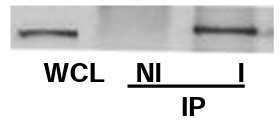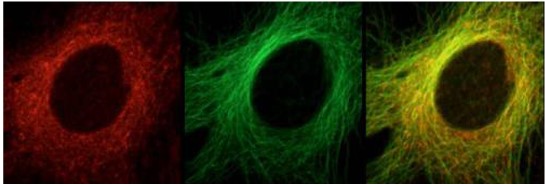Anti-ch-TOG Antibody (34032)
Data
- -
- -
Antibody DetailsProduct DetailsReactive Species Human ⋅ Mouse Host Species Rabbit Immunogen NH2 terminal cysteine-peptide corresponding to aa 2019-2032 in the carboxyl terminal region of human ch- TOG coupled to KLH: NH2-CDLKKRLERIKSSRK-COOH. Product Concentration Lot Specific Formulation Whole antiserum State of Matter Liquid Product Preparation Whole antiserum Storage and Handling This antibody is stable for at least one (1) year at -20°C. Avoid multiple freeze- thaw cycles. Country of Origin USA Shipping Next Day 2-8°C Applications and Recommended Usage? Quality Tested by Leinco Immunoblotting: use at 1:5,000-1:10,000 dilution. A band of approx. 215kDa is detected.
Immunoprecipitation: use at 1:5,000- 1:10,000 dilution. Immunofluorescence: use at 1:5,000- 1:10,000 dilution. These are recommended concentrations. User should determine optimal concentrations for their applications. Each investigator should determine their own optimal working dilution for specific applications. See directions on lot specific datasheets, as information may periodically change. DescriptionDescriptionSpecificity Rabbit Polyclonal Antibody specific to ch-TOG Background Colonic and hepatic tumor over-expressed protein (ch-TOG) belongs to the TOG/XMAP215/Dis1 evolutionarily ancient family of microtubule-associated proteins with isoforms found in all major kingdoms of eukaryotes. This protein is required for the assembly and function of the meiotic or mitotic spindles during cell division and is localized to microtubule-organizing centers (MTOCs) during interphase or to the spindle poles and centrosomes during mitosis or cytokinesis. Function Binds to the plus end of microtubules and regulates microtubule dynamics and microtubule organization. Acts as processive microtubule polymerase. Promotes cytoplasmic microtubule nucleation and elongation. Plays a major role in organizing spindle poles. In spindle formation protects kinetochore microtubules from depolymerization by KIF2C and has an essential role in centrosomal microtubule assembly independently of KIF2C activity. Contributes to centrosome integrity. Acts as component of the TACC3/ch-TOG/clathrin complex proposed to contribute to stabilization of kinetochore fibers of the mitotic spindle by acting as inter-microtubule bridge. The TACC3/ch-TOG/clathrin complex is required for the maintenance of kinetochore fiber tension (PubMed:23532825). Enhances the strength of NDC80 complex-mediated kinetochore-tip microtubule attachments (PubMed:27156448). {PubMed:12569123, PubMed:18809577, PubMed:21297582, PubMed:21646404, PubMed:23532825, PubMed:27156448, PubMed:9570755}. NCBI Gene Bank ID UniProt.org Research Area Cancer Research References & CitationsBarr, A. R.& Bakal, C. Sci Rep. 2015 Jun 3 5:10564 Technical ProtocolsCertificate of Analysis |




